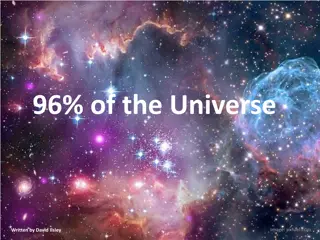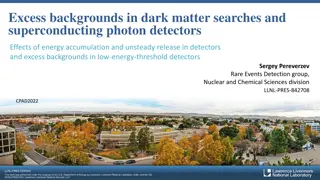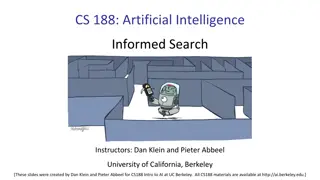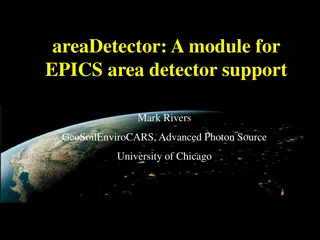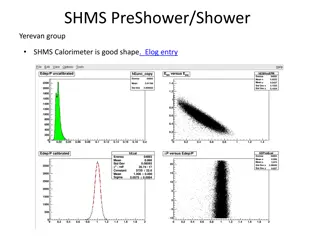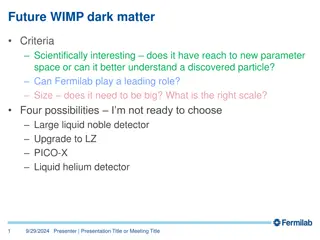Search for Dark Photons Utilizing Advanced Germanium Detectors at University of South Dakota
Research at the University of South Dakota under the collaboration PIRE-GEMADARC focuses on developing advanced germanium detectors with low energy thresholds for detecting low mass dark photons. The study aims to optimize event detection using new Ge detectors with internal charge amplification. The motivation lies in the search for dark photons through U(1) gauge symmetry and kinetic mixing with standard model photons. Detection techniques involve tailored experimental designs to search for dark photons within specific mass vs. coupling parameter spaces, targeting solar and dark halo sources. Solar dark photon flux and detection methods are explored, providing insight into the potential presence of dark photons.
Download Presentation

Please find below an Image/Link to download the presentation.
The content on the website is provided AS IS for your information and personal use only. It may not be sold, licensed, or shared on other websites without obtaining consent from the author. Download presentation by click this link. If you encounter any issues during the download, it is possible that the publisher has removed the file from their server.
E N D
Presentation Transcript
Search for Dark Photons Utilizing Advanced Germanium Detectors Sanjay Bhattarai , Dongming Mei UNIVERSITY OF SOUTH DAKOTA This work is done under the collaboration PIRE-GEMADARC. It was sponsored by NSF OISE-1743790 1
Motivations Research and development of advanced germanium detector with low energy threshold for low mass dark photon detection. Utilizing home-grown crystals at USD to develop new Ge detectors with internal charge amplification Use a low-energy threshold to optimize the number of events. 2
Introduction Introduction U (1) gauge symmetry mediated by a massive spin-1 boson called a dark photon Kinetically Mix with Standard Model (SM) Photon by a small coupling ? through a Lagrangian term: ??=1 2?????? ???= Field strength of SM photon ?? Through this mixing, the dark photon would couple to electromagnetically-charged SM particles analogously to the SM photon. May have very small mass unlike ordinary photon. ?? FIGURE: Example of a one-loop diagram that could create a kinetic mixing. In this case, the massive particle M has both electromagnetic and dark charge. ??= Field strength of dark photon 3
Detection Detection Since neither the mass of the dark photon (??) nor its coupling (?) are known a priori, each experiment s design is tailored to search for it in a specific range in the mass vs. coupling parameter space. Sources and Characteristics: Astrophysical sources: Sun is the main source. Dark Halo is another source. Difference in flux between dark halo and solar sources. Abundance in flux from the Sun. We propose the direct detection technique using advanced HPGe detectors with internal charge amplification. 4
Solar Dark Photons Flux For transverse dark photons Mass ?? = 0.1eV, k = 10 10 ?? ???= 2.7 1028? 2.98???( ? 4 ; ? = ?/??? 1.4) ?2 ?? Flux= For longitudinal dark photons (1 ?? < ? < 300 ??); ???????? ?????????(??) = ?(??) Radial cordinate inside sun Figure : Values of solar parameters for this work ; temperature T (blue), radial coordinate r (pink), ??? ??(brown) normalized to their largest values 1350 eV, 6.96 108 ? and 5.8 10 4 ??2? 1 2?2 ? ?2??? ?? 2 ?2 ?? 2 ?? ???= 2?2 ?? Flux = 2 2 ? ? 1) (? Temperature Ref: J. Redondo, J. Cosmol. Astropart. Phys. 07 (2008) 008 For ? > 300 ?? ?? ???=5.7 1033 ? 4? ?/1.7?2?? 2 5
Dark Photon Flux: 0.1 eV , K= 10^-10 1.00E+18 1.00E+17 1.00E+16 1.00E+15 Flux (ev^-1s^-1cm^-2) 1.00E+14 1.00E+13 1.00E+12 1.00E+11 1.00E+10 flux (trans) 1.00E+09 flux (long) 1.00E+08 1.00E+07 1.00E+06 1.00E+05 1.00E+04 1.00E+03 1.00E+02 10 100 Dark Photon Energy (eV) 1000 10000 Ref: H. An, M. Pospelov, and J. Pradler, Phys. Lett. B 725, 190 (2013) 6
Event rate 1.00E+07 1.00E+06 Event rate (Kg^-1s^-1kev^-1) 1.00E+05 For detector of mass M and volume V Event rate = ? ? {????? ?????????? ?????( ?) + ????? ?????????? ?????( ?)} 1.00E+04 1.00E+03 1.00E+02 1.00E+01 1.00E+00 1.00E-01 2??? 1???? ?2?? 1.00E-02 Here, ?= ?=?2??? 1???? 1.00E-03 ?2 ?2 1.00E-04 0 500 1000 Dark Photon energy (eV) 1500 2000 2500 3000 Where, ???? is photoabsorption cross-section, ??is atomic density , ? 1 is the velocity of dark photons Ref: B. L. Henke, E. M. Gullikson and J. C. Davis, Atom. Data Nucl. Data Tabl. 54, no. 2, 181 (1993). 7
Phonon impurity interaction Phonon impurity interaction Phonons with energy 0.037eV and 0.026eV can ionize or excite impurities to produce charge carriers.(ionization energy of impurities~0.01eV) ??= Neutral donors ??= Neutral acceptors ??= ?????? ???????? ?? ??????? ?????? ??=energy absorbed by neutral acceptors ?+=Daughter donor charged impurity ? =Daughter acceptor charged impurity At low temperatures (~4k), impurities freezes to neutral impurities ,scattering of phonons is dominated by these neutral impurities D.-M. Mei, G.-J. Wang, H. Mei, G. Yang, J. Liu, M. Wag-ner, R. Panth, K. Kooi, Y.-Y. Yang, and W.-Z. Wei, TheEuropean Physical Journal C78, 187 (2018). 8
Proposed detector Proposed detector Multistrip planar Ge detector of mass about 1 Kg with impurity level of 1 3 1010/??3 and has a dimension of 9 7 3 ??3. Ge crystal that guarantees a uniform distribution of impurities to provide a homogeneous electric field near the anode Guarantee reliable cooling of the crystal, since the critical electric field and amplification factor depend on the free path of charge carriers, which in turn depend on the temperature. Amplifaction factor of ~1000 1. Anode strips 2. Cathode 3. Guard electrodes A. S. Starostin and A. G. Beda, Phys. Atom. Nucl. 63 (2000) 1297-1300, arXiv:hepex/0002063v1. 9
Ionization probability Ionization probability The probability for a neutral acceptor state to be ionized in a p-type detector is 1 ?(??) = 1 1 + 4?(?? ??)/??? ??= Fermi energy level ?? ??= ????(?? ? =effective mass of hole ? ?? 3/2 ??) Where ??= 2 2?? ?? 2 1 = 1 1 + 4exp[( ?? ?? + ?? ??)/??] ?? ??= Phonon Energy 10
Absorption probability of phonon Absorption probability of phonon The ionization or excitation cross section of both over-charged and neutral impurities=? = 5 10 13??2 Absorption probability ? is given by ?=1 ? ?/? 1 ??? d=average distance diffused before anharmonic decay where ? = 11
Number of charge carriers The number of charge carriers created by the ionization or excitation of impurities ?????????= ?????? ? For ith phonon with ionization probabaility ?? and absorption probability ??. ?????????= ? ?.??? ? ?+????[( ?? ??+ ?? ?? ?)/??]) ?? ??= ????(?? 3/2 ?????????? ? (? ? ??/?) (? ??) Where ??= 2 2?? ?? 2 ? =effective mass of hole=0.29me 12
HPGe detector at low temperature At high electric field and low temperature we can achieve internal charge amplification At low temperature , detector not required to deplete Plots Source: Rajendra Pant s experiment with detector of impurity concentration ~1010/??3 13
Future Work Fabricate two planar detectors; a p- type and n type each with impurity level ~1012/??3. Higher the impurity higher the phonons. Test at low tempearutre, depletion not required. Fabrictae point contact detector , test at high field and low temperature to observe internal charge amplification. 14
Conclusion Conclusion Low mass solar dark photon can be detected using advanced germanium detector of threshold 0.1 eV. Background study for the project yet to be studied. Crystal growth and zone refining yields the high purity germanium of desired impurities ; detector yet to be fabricated. 15
THANK YOU 16


